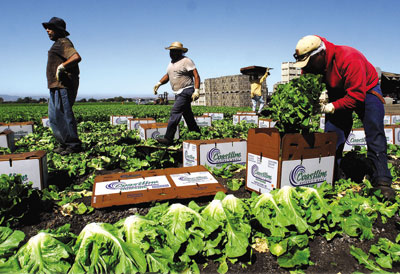
Local growers of spinach and lettuce now have another way of
eradicating harmful germs such as E. coli after the Food and Drug
Administration has approved irradiation as a method to reduce
food-borne hazards.
photo gallery of the spinach being picked and processed.
Local growers of spinach and lettuce now have another way of eradicating harmful germs such as E. coli after the Food and Drug Administration has approved irradiation as a method to reduce food-borne hazards.
Critics call the move by the FDA everything from unnecessary to an expensive gimmick, but local farmers and agricultural organizations seem to think that the move is a step in the right direction.
The infamous E. coli outbreak of 2006 was traced to San Benito County bagged baby spinach. The produce was grown and packaged by Natural Selection Foods and Dole in San Juan Bautista. The outbreak resulted in 205 confirmed cases of illness. Of these, 104 people required hospitalization and four people died.
Irradiation may have been able to prevent that outbreak, as many major health organization concur that irradiation is an effective way of eliminating E. coli from produce like spinach. It is a process in which foods are exposed for very short periods of time in a sheltered area to a radiant energy source. Gamma rays, electron beams, and the newest technique – x irradiation – are examples of such sources.
Irradiation directly damages DNA of living organisms making them unable to grow or reproduce, according to the Centers for Disease Control and Prevention.
The irradiation procedure may seem like something out of a science fiction novel, but it has been used for years with great success on meat, particularly meat such as pork that is known to harbor harmful bacteria.
A spokesman for the Western Growers Association said the group is “thrilled with any new technology or advancement that improves safety.”
“We are pleased that there is another vehicle that is a key safety move during a time of increasing outbreaks from raw produce,” said Paul Simonds, the group spokesman.
Simonds also noted how this approval is the start of a process that needs additional study and thought to make irradiation economically feasible for growers.
The idea of affordability is intertwined with irradiation’s place in what is known as “The Leafy Green Marketing Agreement.” This agreement was formed in 2007 largely in response to the 2006 E. coli outbreak.
Because of the exhaustive look at and implementation of “best practices” in the leafy green agreement, some local farmers said irradiation is an unwieldy and expensive step that needs further study before it can be demonstrated as worthwhile.
“I think there is still a great deal to be learned and a lot more testing that needs to be done,” said Kay Filice of Filice Farms. “This will be another tool in the toolbox, but the Leafy Green Marketing Agreement is working very well.”
Filice noted that local growers of spinach and lettuce have put enormous effort into developing incredibly high standards and practices to make healthy and safe products.
“Our food supply is currently very safe because of our commitment to follow high food standards set forth by the LGMA,” Filice underscored.
A national nonprofit group known as Food & Water Watch believes there has been far too little testing of irradiation and that there are potential health concerns.
“Nearly two years after a major E. coli outbreak was linked to California spinach, it is unbelievable that the FDA’s first action on this issue is to turn to irradiation rather than focus on how to prevent contamination of these crops,” said Wenonah Hauter, Food & Water Watch executive director, whose office is based in San Francisco.
Hauter further stated that instead of beefing up the inspection and safety processes, “all the FDA has to offer consumers is an impractical, ineffective and very expensive gimmick like irradiation.”
Governmental organizations, however, stand firmly behind irradiation’s effectiveness. The CDC likens objections such as Hauter’s to opposition that initially surfaced when pasteurization was first introduced.
“The Centers for Disease Control and Prevention, along with the World Health Organization and many other health organizations, welcomes the use of food irradiation as an important technology that can protect the public against food borne diseases,” states the CDC Web site.
Filice takes the middle ground: “Exploring irradiation won’t diminish the diligent efforts local growers have been making to put healthy food on the nation’s table.”
Simonds of Western Growers agrees.
“Irradiation does not replace our adherence to newly-enhanced, best practices – it simply adds to them.”









